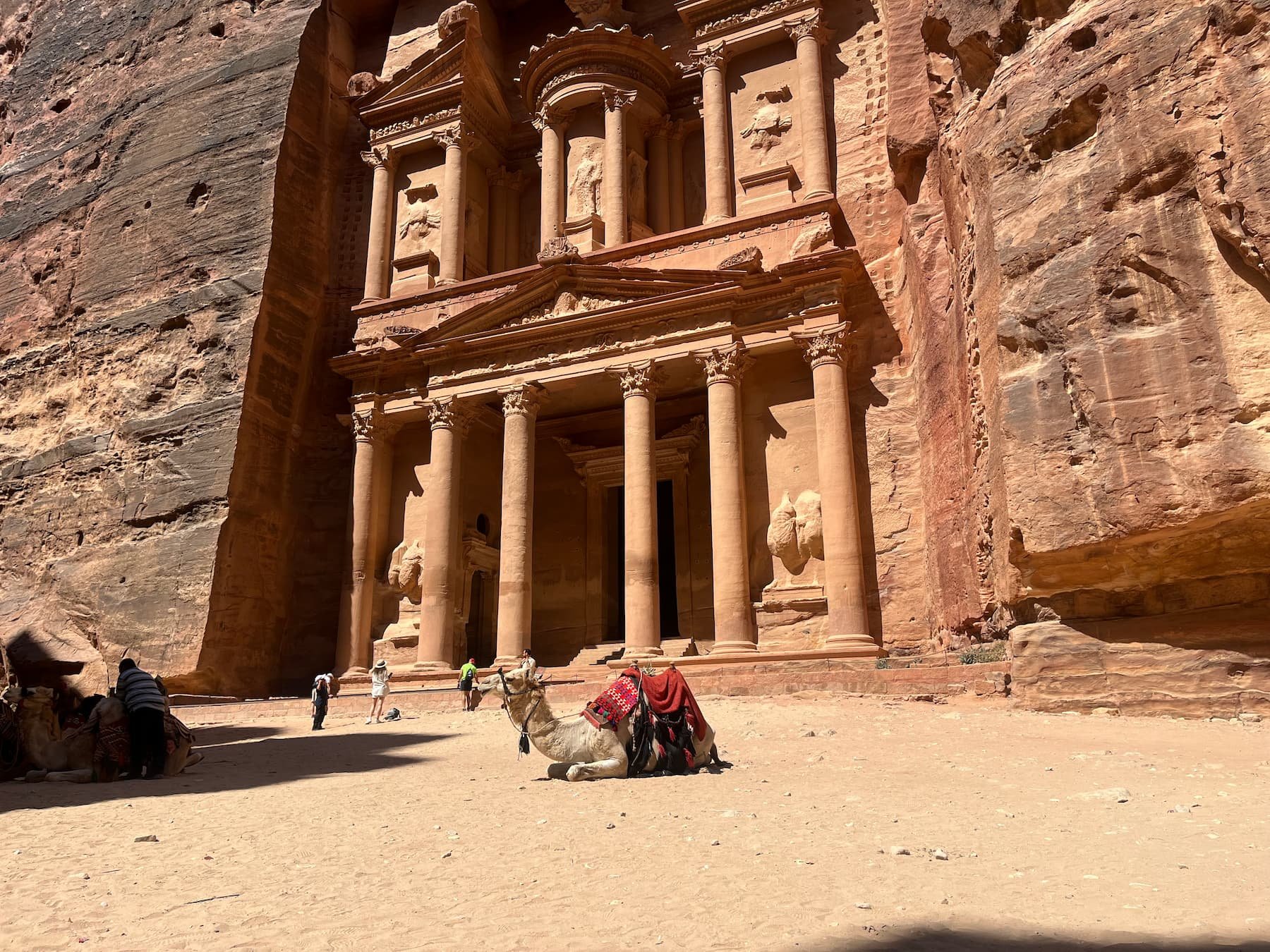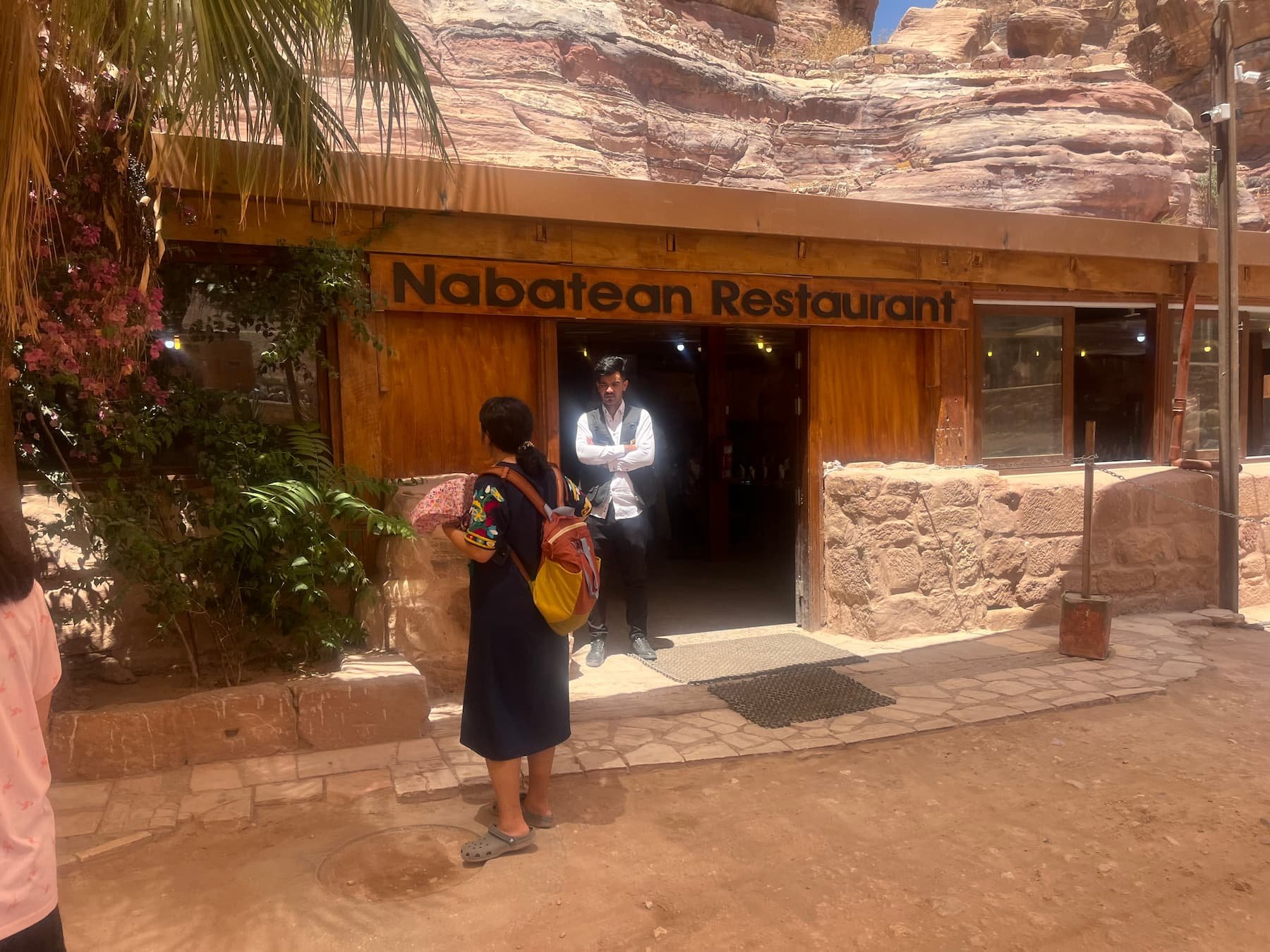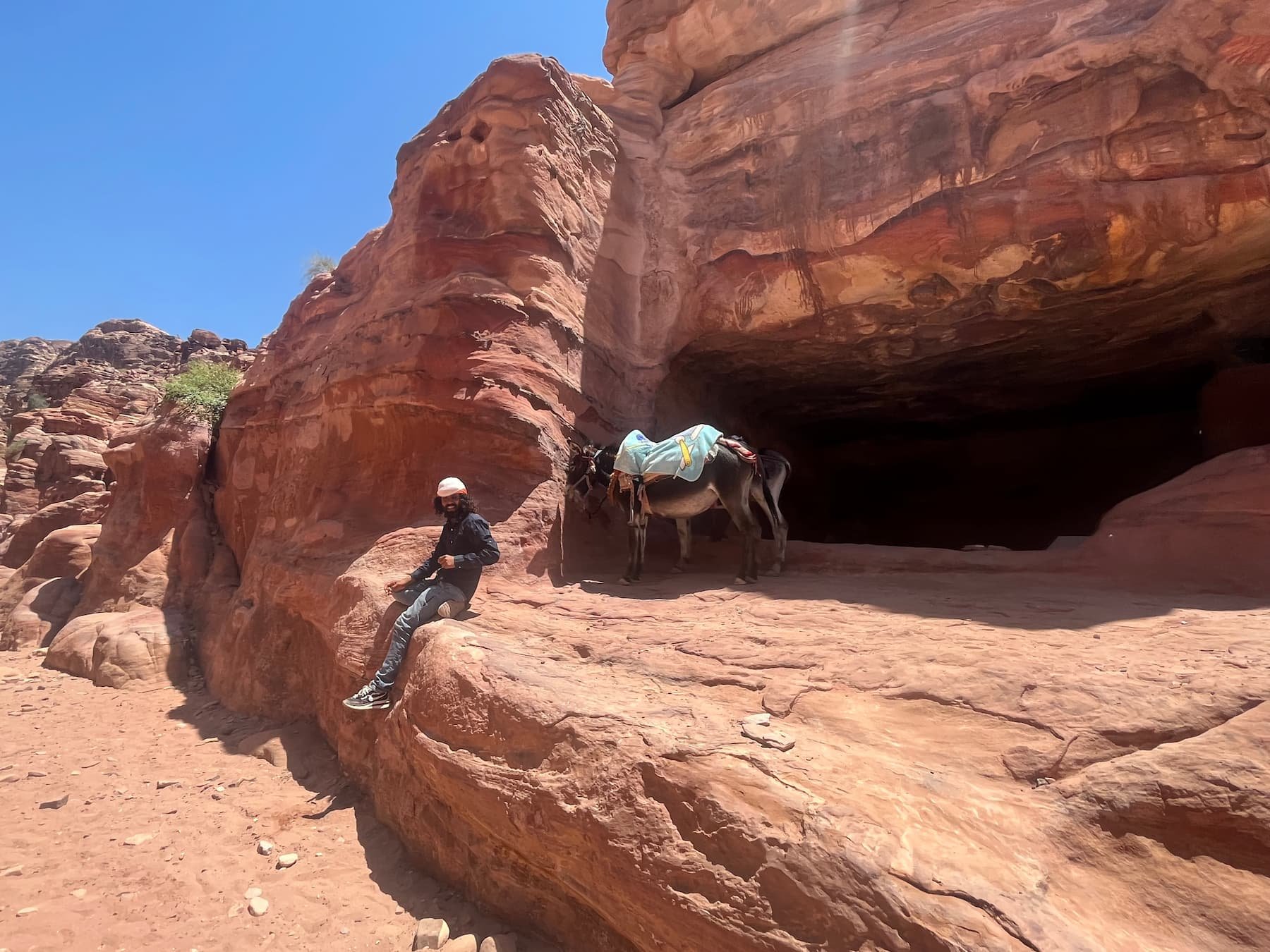23 fascinating facts on Petra in Jordan to learn before you visit.
As I wandered around the final corner of the Siq and the Treasury was revealed..
I instantly realised why the famous spot has been in so many Hollywood movies.
Petra is something else!
There is more to the archaeological site than movies though, so I have listed some fascinating facts on Petra which date back thousands of years.
Learning these facts before you visit will enhance your experience of the Lost City, and the local Bedouin people, who have lived in the city dating back to the Nabatean period.
I loved my day out at Petra, and enjoyed the hands-on history lesson it provided!
Let’s start with the meaning of the name ‘Petra’.
Stood in front of the famous ‘Treasury’.
Meaning in the Name.
The word "Petra" itself comes from Greek and translates to "rock," a fitting name for a city carved from a massive rock face.
It is one of the most unique landscapes that I have visited during my travels, with surreal rock formations and facades appearing around each corner of the site.
It is hard to believe that civilisations had the capabilities of such engineering feats thousands of years ago.
Camels are a popular mode of transport at Petra.
A city of nicknames.
The Lost City.
While it wasn't truly lost, Petra's isolation from major trade routes after the Roman Empire declined led to its rediscovery by a Western explorer in 1812, earning it the nickname.
The Rose City.
The rose-red sandstone cliffs from which Petra is carved give it another nickname, the Rose City. The colour is especially breathtaking in the golden light of dawn and dusk.
I found the sandstone cliffs to be breathtaking, and some of the best scenery across the archaeological site. Perfect for some Jordan Instagram shots.
You will get the opportunity to really immerse in nature as you tackle the climb up to the Monastery, as the whole surrounding area are giant rocks and cliffs, which have been naturally formed in incredible ways.
The cave restaurants offer some much needed shade.
A picture perfect site.
Hollywood Fame.
Petra has been featured in several films, most notably Indiana Jones and the Last Crusade, showcasing its dramatic scenery to a wider audience.
The combination of natural rock formations with man made facades and tombs, along with ancient temples, and Roman theatres makes Petra one of the most popular sites in the world for films.
At times during my visit, I felt as though I was inside a movie!
Clear blue skies offered an awesome backdrop for the beauty of Petra.
Jordan is full of many picturesque landscapes which have been used for blockbuster films.
Some notable films which have been filmed in Jordan are:
Indiana Jones and the Last Crusade.
The Martian.
Lawrence of Arabia.
Transformers - Revenge of the Fallen.
Dune 2.
The ‘Hollywood shot’.
A forever home.
A Living City.
Even today, local Bedouin people maintain a presence in Petra, offering visitors glimpses into the region's traditional culture.
I found it fascinating how some of the locals spend their lives on a daily basis.
The high ledges and dark caves are home to some Bedouins.
Although the tourism money is the main factor in why the locals live like this, they are still very humble and will go above and beyond to help teach you about their traditions and culture.
In the popular photo spots, the local children make great photographers!
Many locals spend most days chilling high up in the rocks of Petra.
Ancient Origins.
Founded in 312 BC by the Nabataeans, and Arab people, Petra is one of the oldest continuously inhabited cities in the world.
As I wandered around the site, I noticed many ancient traditions are still in place.
It is like Petra is stuck in time!
The locals ride horseback and camels to get around, some shops sell spices such as frankincense, and living on bare necessities is the norm.
Quite the eye opener, along with other stops on my Jordan itinerary.
A local selling spices.
Some tips for your Petra trip.
Purchasing a Jordan Pass in advance of visiting Jordan covers your Petra entrance, along with other major sites such as Wadi Rum, and Little Petra, along with your visa, so it is cost effective. Wadi Mujib and Mount Nebo were not included though.
I found that visiting first thing helped to beat the crowds, however, I did visit at the least popular time of year, but the same applies in peak months.
Wearing comfortable shoes can be the difference between a great day and a terrible one. There is a lot of walking at Petra, which is made more difficult by hot temperatures and some tough climbs.
There are places to purchase water, however, you should carry a bottle with you at all times to keep your hydration levels at a healthy level.
Plan your Petra route in advance to make sure you include all the famous spots in your exploration of the Lost City.
Carry some low denominations of local currency to haggle with locals easier, or to leave some tips which are well deserved for the locals working in the heat.
Don’t ride the donkeys at Petra. They hide in the shade all day due to the scorching sun, so adding your weight is not fair on them!
Some mind-blowing architecture.
Carved Marvel.
Unlike many cities built on existing ground, Petra is half-built, half-carved directly into the rose-red sandstone cliffs.
The most striking feature of Petra is its elaborate architecture, carved directly into the red sandstone cliffs.
This unique technique, combining Hellenistic influences with Nabataean traditions, resulted in iconic structures like the Treasury (Al-Khazneh) and the Monastery (Ad-Deir).
These structures showcase exceptional artistry and engineering skills.
You have to witness them in person to fully appreciate its beauty!
Architectural Masterpieces.
Beyond the Treasury, Petra boasts numerous other architectural wonders, including monasteries, temples, and a Roman-style theatre.
Visitors are allowed to explore all of these different landmarks inside the site at their own leisure.
I would recommend two days if you really want to delve deep into the ancient history across the different sites.
There are rock carvings throughout the site.
The Treasury.
More Than a Treasury.
The Al-Khazneh, perhaps Petra's most famous landmark, is actually a mausoleum, though its exact purpose remains debated.
This spot in Petra is the most famous for a reason.
I struggled to comprehend the skills involved in carving the rocks to create such beauty.
If you want to make the most of the aesthetics of the Treasury, you can head to the various viewing platforms located high in the cliffs opposite.
A camel in prime position.
Tombs.
City of Tombs.
Over 1,000 tombs are scattered throughout Petra, a testament to the elaborate burial practices of the Nabataeans.
I found that tombs aren’t usually associated with Jordan, or one of the big lures to the country, however, as I walked around the Petra site, I found the tombs to be aesthetically pleasing and they definitely add to the character of the site!
Visitors are free to walk around inside and outside the tombs, although there is not much to see inside. They don’t have the same level of detail as the tombs in Egypt which I visited.
Some tombs at Petra.
Royal Tombs.
Four particularly impressive tombs, known as the Royal Tombs, stand out for their size and intricate facades.
The elaborate carvings and grand facades of the Royal Tombs at Petra might lead you to believe they were exclusively for royalty.
However, archaeologists believe the Royal Tombs were most likely burial sites for high-ranking Nabataean officials, not just for kings.
It is thought that the name "Royal Tombs" was likely given by later visitors to Petra, impressed by the size and ornamentation of the structures.
Original Name.
The Nabataeans called their city Raqmu, which translates to "the variegated one," likely referencing the multicoloured sandstone cliffs.
My favourite spot in Petra for the multi coloured cliffs was on my walk up to the Monastery.
As I made my way up the 800 steps into the mountains the views were awesome.
It felt like the scenery of a cartoon in my mind, as I immersed myself nature.
The beautiful coloured sandstone cliffs.
The best tour to experience Petra.
From Amman: Private Petra Day Trip with Guide.
If you want to experience Petra in an educational way, then a local tour guide is a must.
This Petra Day tour is perfect, as you will receive detailed information about each section in real time as you explore the Lost City.
The local Bedouins in Wadi Musa and surrounding archaeological sites are famous for their joyous character and willingness to go the extra mile to show tourists a good time.
I loved the fact that the logistics of the tour are all covered in the price, including entrance tickets, and return transport to and from Amman.
The luxury vehicle makes the windy roads of the Kings Highway much easier to enjoy.
Check out the Petra Day tour prices & availability on GetyourGuide.
Hidden treasures await future visitors.
Hidden City.
Many structures in Petra are still being discovered, with only an estimated 15% of the city fully excavated.
Despite Petra offering visitors a huge archaeological site to explore, which can take multiple days, it is expected that future generations will have many more tombs and treasures to enjoy, once excavations continue to reveal them.
A local restaurant.
An exciting wander.
Siq: The Grand Entrance.
Visitors enter Petra through a narrow gorge called the Siq, which winds for over a kilometre, creating a suspenseful buildup before revealing the city's first monuments.
This was definitely one of the most exciting aspects of my day at Petra, as I visited first thing in the morning before the crowds arrived. This created a surreal moment of solitude with towering rocks.
The narrowest point of the Siq is believed to be only 3 metres (9.8 feet) wide.
The highlight is walking towards the exit as the Treasury is revealed.
Walking the famous Siq.
Where to stay near Petra.
The closest town to Petra is Wadi Musa, which is home to some great accommodation options to suit all budgets, however, Petra is such a good day trip, it is recommended that you make the experience extra special!
Petra Bubble Luxotel.
The perfect place to feel the charm of the Bedouins is in one of Jordan’s famous bubble hotels.
Petra Bubble Luxotel is located around 10 km from the main Petra entrance in the desert close to Little Petra, and offers tranquil vibes for guests.
Spending your nights in a bubble looking up at Jordan’s starry sky is the ideal preparation for your excursions around Petra.
The hot tubs, sunset evening meals included in the price further enhance your one-of-a-kind experience.
A protected site.
World Heritage Site.
Recognised for its cultural and historical significance, Petra was designated a UNESCO World Heritage Site in 1985.
The site’s exceptional testimony to a lost civilisation is one of the main factors in the decision.
Petra was the capital of the Nabataean kingdom, a powerful trading civilization that flourished from around the 4th century BC to the 2nd century AD.
The archaeological remains at Petra offer a wealth of information about their culture, engineering skills, and way of life.
Limited Written Records.
Unlike some other civilizations, the Nabataeans didn't leave behind extensive written records. Petra serves as a crucial physical record of their history and achievements.
A Wonder of the World.
In 2007, Petra was chosen as one of the New Seven Wonders of the World, solidifying its place as a global tourist destination.
This was definitely the correct choice, as the Petra site is like another world.
It is my favourite travel experience so far on my travels, and was one of my bucket list destinations, so it certainly lived up to the hype I had given it before visiting.
The locals are very protective :)
A functional city.
A Flourishing Capital.
During the 1st century AD, Petra was the capital of the Nabataean Kingdom, a centre of trade and culture.
Petra wasn't an isolated desert city. As a trade centre, it attracted people from various cultures, leading to a cosmopolitan atmosphere.
Greek, Roman, and other influences likely blended with Nabataean traditions in various aspects of life.
Trading Hub.
Petra's location along major trade routes for frankincense, spices, and other goods made it a wealthy and strategic city.
The city likely had a bustling marketplace filled with merchants, vendors, and artisans selling a variety of goods. Imagine the sights, sounds, and smells of a thriving marketplace filled with exotic wares.
Engineering Marvel.
The Nabataeans were skilled engineers who developed ingenious water management systems to sustain life in the arid region.
This intricate water system was largely invisible, with channels carved into the rock and cisterns hidden underground. Imagine the city functioning with a seemingly magical water supply.
A quirky local.
A religious centre.
Biblical Connection.
Some scholars believe that Petra is the location mentioned in the Bible as the city of Sela, an Edomite stronghold conquered by the Nabataeans.
Petra's location in Edom, along with its historical significance during the time period mentioned in the Bible, strengthens the connection.
Edom was a kingdom bordering ancient Judah, and the capture of Sela by Amaziah aligns with the known conflicts between these kingdoms.
The High Place of Sacrifice.
This mountaintop complex served as a religious centre for the Nabataeans, offering stunning panoramic views of the surrounding landscape.
Several high places of worship have been identified within Petra, including Al-Khubtha and Ad-Deir (the Monastery). These high locations might have been chosen for their symbolic connection to the divine.
The monastery.
A timeless wonder.
Enduring Legacy.
Despite its decline after Roman rule, Petra's remarkable architecture and historical significance continue to inspire awe centuries later.
I found the Roman theatre to be fascinating having already visited the famous theatre in Amman earlier in my Jordan trip.
And as I wandered around the ruins of the Great Temple, it felt like I was in an Indiana Jones movie, with the ancient surroundings being surreal.
The impressive Roman Theatre.
Other popular spots in Jordan.
There is no doubt that Petra is the main attraction in Jordan, however, there are other places that should be on your Jordan itinerary.
Amman.
The Jordanian capital is usually only a short stop for International tourists, however, the city is unique, as it combines ancient landmarks with a modern twist of Graffiti art and party streets.
My favourite part of our day in the capital were the views from on top of the Citadel hill.
Wadi Rum Desert.
Another natural treasure of Jordan is the famous Wadi Rum Desert, which homes many Bedouin communities.
Many tourists ask Petra or Wadi Rum?
I feel as though they both need to be experienced to feel the full Bedouin magic.
I loved our jeep tour through the desert, which was followed by a night under the stars in a Bedouin camp.
We experienced the Zarbing method of cooking for the first time and enjoyed a feast with great company.
You can’t miss this one!
Disclosure: I sometimes use affiliate marketing. This will not cost you anything, but helps with my travel costs. I only recommend companies I use myself.
















